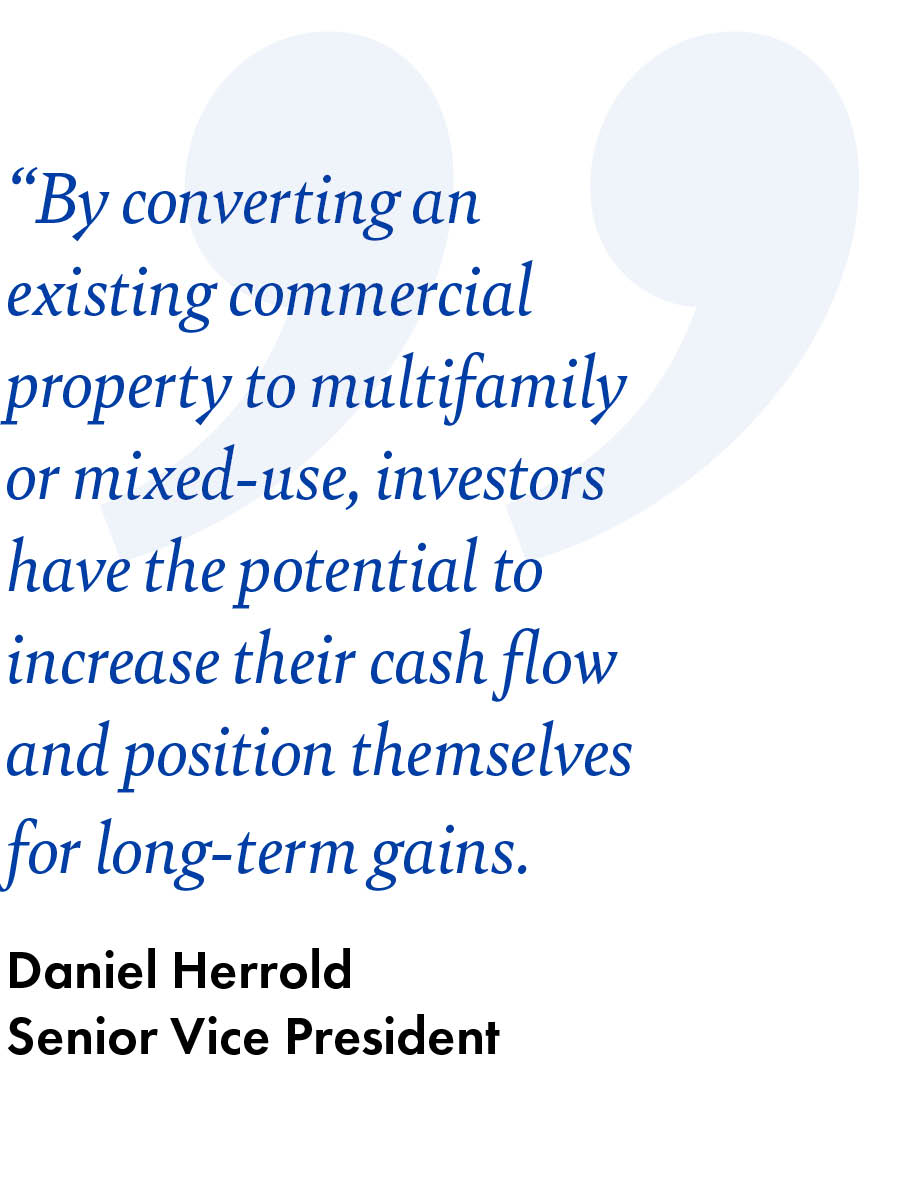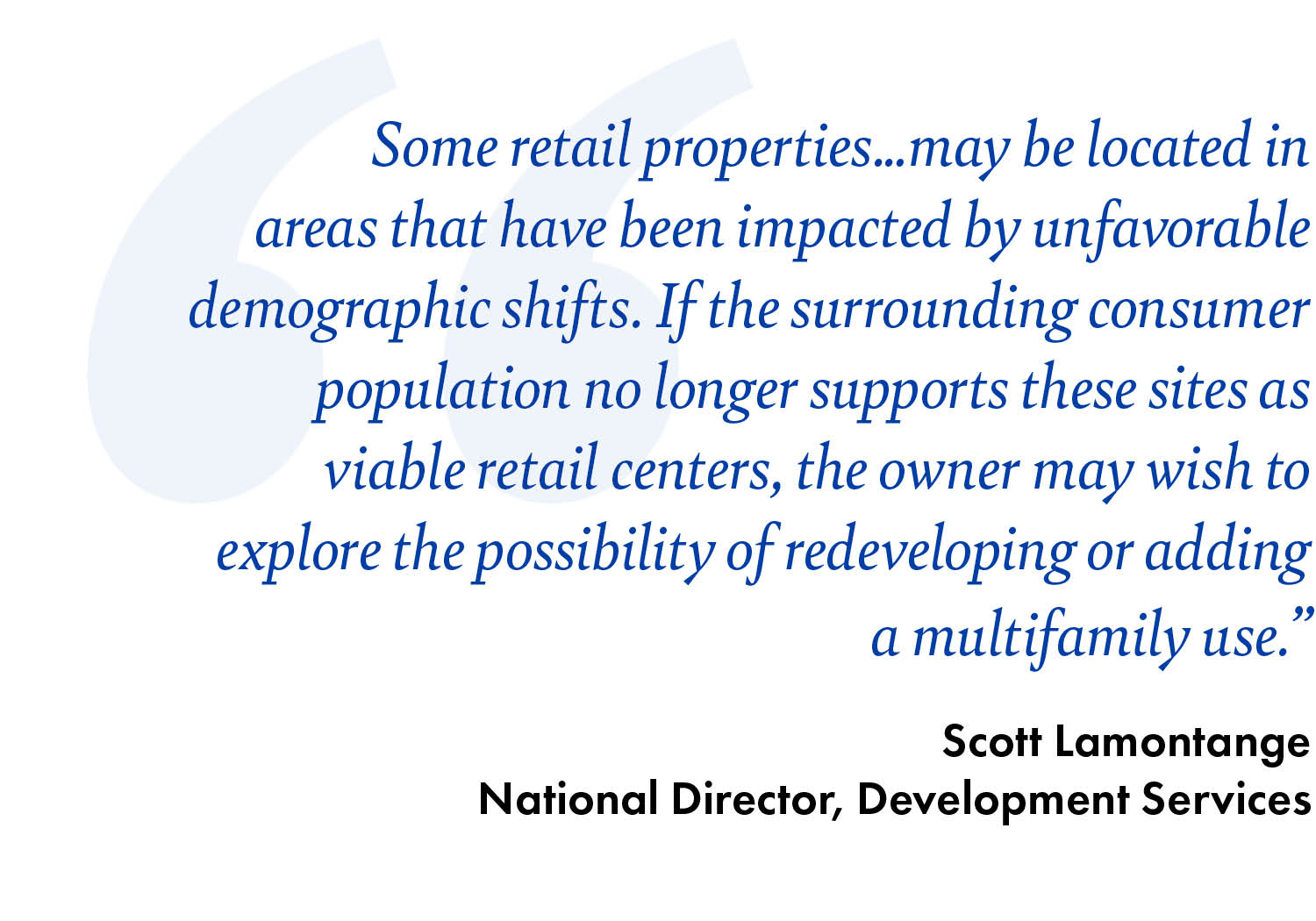Redeveloping the Future: Converting Commercial Assets to Multifamily to Unlock Hidden Value

Over the last several decades, consumer shopping patterns and preferences have been changing. In the 1980s, enclosed malls were a dominant part of the retail landscape, influencing everything from consumer behavior to pop culture. By the early 2000s, preferences had begun shifting to open air shopping centers, and consumers began relying more on neighborhood and community centers with big box anchors. Now, in the aftermath of the COVID-19 pandemic and with strong reliance on online shopping, brick-and-mortar retail continues to evolve. As we see an uptick in existing retail facilities becoming functionally obsolete in the face of these shifting consumer patterns, many investors are questioning the highest and best use of their properties and evaluating their real estate portfolios to identify opportunities that will maximize value now and into the future.
One option investors may consider is converting or redeveloping outdated or underutilized commercial space to a multifamily use. With this repositioning, investors can help address the shortage of housing options available to the nation’s growing population, as well as potentially increase the value of their assets by replacing obsolescence or activating existing retail by adding a built-in consumer base. But residential conversions may not be possible for every property or in every situation. Here, we discuss the benefits and challenges investors may face when considering this option.
When Might a Commercial-to-Residential Redevelopment Be Right?
If commercial sites meet specific criteria, it may make sense for investors to explore a commercial-to-residential redevelopment or conversion. Some retail properties – including regional and enclosed shopping malls, as well as power centers – that were built years ago may be located in areas that have been impacted by unfavorable demographic shifts. If the surrounding consumer population no longer supports these sites as viable retail centers, the owner may wish to explore the possibility of redeveloping or adding a multifamily use.
Similarly, many commercial properties that have become functionally obsolete may be ripe for redevelopment. Industrial properties in urban areas, for example, are served by streets too narrow for large semis and trailers to access, and they offer clear heights that no longer cater to the needs of modern warehouse users. Properties such as these, when converted to residential, can help address in-town housing shortages and allow investors to create substantial value for themselves.
Benefits of Redeveloping Underutilized Commercial Assets
The successful redevelopment of a commercial property or underutilized site can pay significant dividends for a real estate owner. Exploring what is the highest and best use of a particular property can mean the difference between an investment that cash flows and one that sits vacant. If an owner has an under-leased or underutilized retail property, for example, converting a portion of it to multifamily or mixed-use introduces an immediate and direct customer base for the remaining stores. In other scenarios, investors may have small-footprint properties on large parcels of land. By demolishing the existing improvements and building vertically, the increased density translates to increased value.
Beyond the benefits afforded to the investor, many communities across urban, suburban, and rural areas are experiencing housing shortages or simply lack the desired walkability that mixed-use projects provide. Populations are growing and home ownership is becoming more difficult to attain for much of the lower and middle classes. Access to multifamily housing, as well as affordable housing options, is critical to the success of these growing communities. By redeveloping a dark shopping mall or reactivating an existing retail center, an investor can create affordable and accessible housing, walkable neighborhoods, and more stable communities.
lower and middle classes. Access to multifamily housing, as well as affordable housing options, is critical to the success of these growing communities. By redeveloping a dark shopping mall or reactivating an existing retail center, an investor can create affordable and accessible housing, walkable neighborhoods, and more stable communities.
Factors That May Limit Redevelopment Options
Not every underutilized commercial asset, however, is a good candidate for redevelopment. Several characteristics may limit – or even prevent – the possibility of repositioning a property. First is the size of the parcel. Some parcels may be too small to accommodate multifamily construction. Consider a one-acre outparcel to an anchored shopping center. It may be sitting vacant, undeveloped, and therefore underutilized, but a parcel this size in most locations would not be able to accommodate apartments in addition to all the required or expected amenities, such as covered parking or a swimming pool. Generally speaking, investors should refrain from considering a multifamily development if their parcel is less than one and half acres at a minimum, with exceptions for highly dense urban areas. On the flip side, some larger urban tracts can be ripe for large scale mixed-use redevelopment, which generally have a large multifamily component.
Location is also a consideration. Proposed developments located further away from commercial corridors may meet resistance from established neighborhoods, be limited by zoning and use restrictions, or encounter other challenges that would prevent the project from going forward. It’s also possible that residential tenant demand could be lower if a property isn’t well located or easy to access.
Economics present yet another challenge for investors. Rent comparables in the immediate area must be able to support a new development. Constructing a new multifamily community can be extremely expensive, and if a proper market analysis isn’t conducted in advance, an investor may not get the deal to pencil.
Investing in the Future
As investors seek to maximize value across their real estate portfolios, many will look for creative ways to reposition today’s underutilized assets. By converting an existing commercial property to multifamily or mixed-use, investors have the potential to increase their cash flow and position themselves for long-term gains. It’s important to acknowledge, however, that redeveloping every underperforming commercial site to multifamily simply isn’t possible. Size limitations and zoning restrictions, among other considerations, may pose a multitude of challenges. Nevertheless, with careful planning and thorough evaluation, investors can tap into the potential benefits offered by this repositioning strategy. Not only can investors increase the value of their own portfolios, but they can also contribute positively to the creation of vibrant and sustainable communities.
Given the current market headwinds, Northmarq cautions owners to align redevelopment underwriting to institutional standards to ensure project viability.
Read More
Insights
Research to help you make knowledgeable investment decisions


